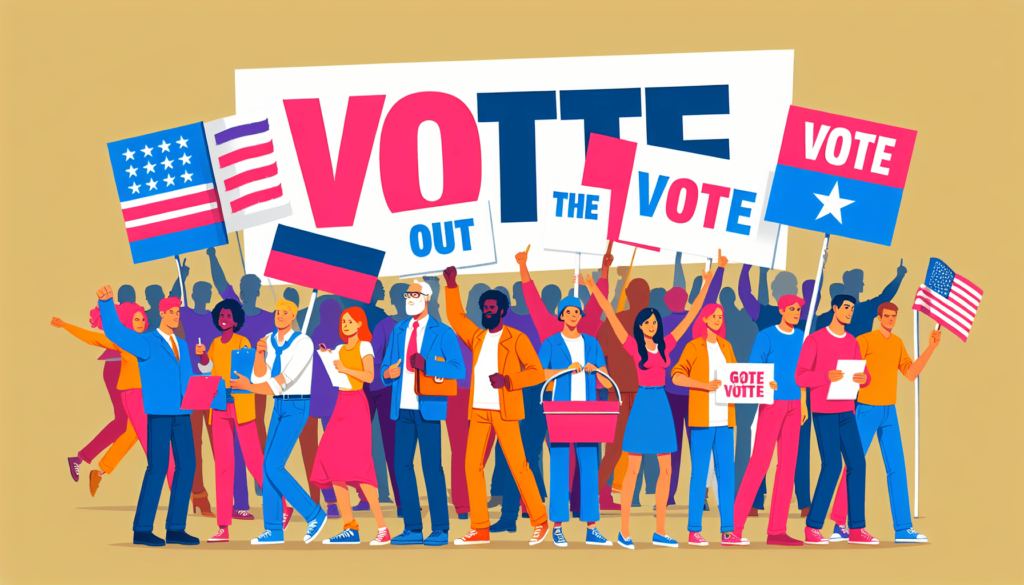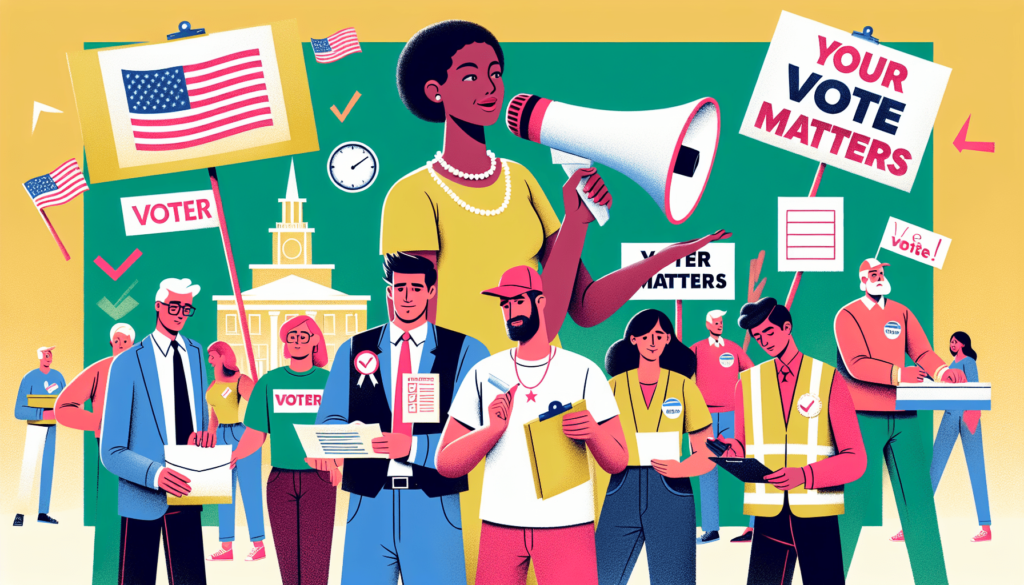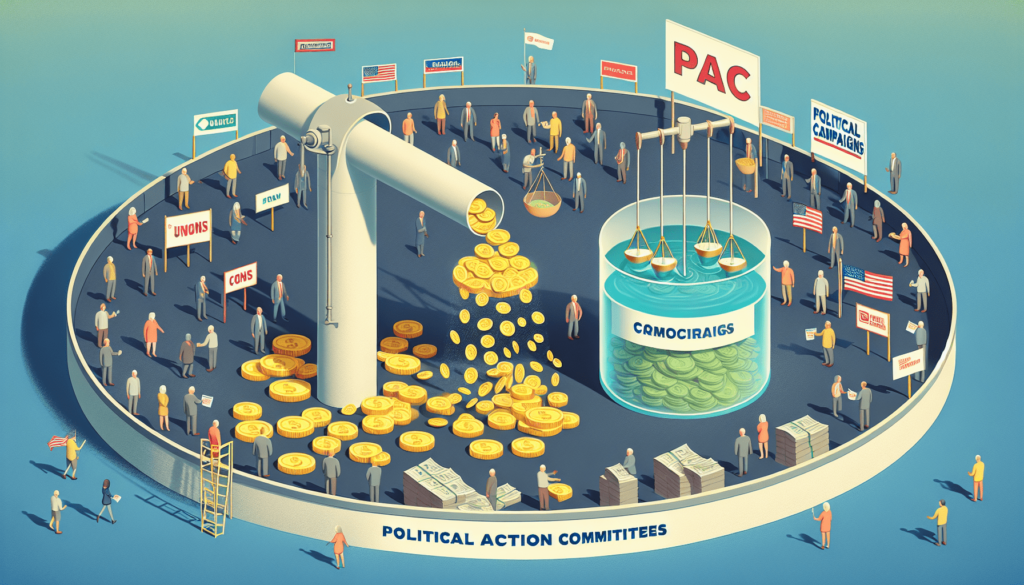Are you curious about the critical role that volunteer recruitment plays in Get Out The Vote (GOTV) efforts? In this article, we will explore the vital importance of recruiting volunteers to ensure the success of political campaigns and help maximize voter turnout. By understanding the significance of volunteer involvement in GOTV initiatives, you will gain valuable insights into the power of grassroots efforts and how they can shape the outcome of elections. So, let’s dive in and uncover the role of volunteer recruitment in GOTV!
Importance of Volunteer Recruitment in GOTV
Increase in Voter Turnout
Volunteer recruitment plays a crucial role in achieving successful Get Out the Vote (GOTV) efforts by increasing voter turnout. Volunteers serve as the backbone of any campaign or organization, as they actively engage with community members, spreading awareness about the importance of voting and encouraging citizens to exercise their democratic rights. By recruiting dedicated volunteers who are passionate about civic engagement, campaigns and organizations can effectively mobilize voters and drive up turnout rates. Volunteers can personally connect with individuals, sharing information about registration deadlines, polling locations, and absentee voting options, thereby boosting participation in the electoral process.
Effective Voter Engagement
Volunteers are instrumental in voter engagement, as they have the ability to establish personal connections with members of the community. Through door-to-door canvassing, phone-banking, and community events, volunteers can engage in meaningful conversations with voters, addressing their concerns and answering any questions they may have regarding the electoral process. This personalized approach creates a sense of trust and encourages voters to actively participate in elections. Volunteers can also assist individuals in understanding complex issues or candidate platforms, helping them make informed and responsible voting decisions. By fostering these one-on-one interactions, volunteer recruitment in GOTV campaigns facilitates strong voter engagement and fosters a vibrant democratic society.
Cost-Effective Approach
Volunteer recruitment offers a cost-effective approach to mobilizing voters. While traditional advertising and outreach methods can be expensive and may not yield the desired results, engaging volunteers proves to be a more budget-friendly alternative. By harnessing the enthusiasm and dedication of volunteers, campaigns and organizations can leverage their efforts to reach a wider audience without incurring substantial financial burdens. Volunteers serve as ambassadors for the cause, spreading the message organically through their networks and communities. This grassroots approach not only saves on costs but also allows for a more genuine and impactful connection with potential voters.
Advocacy and Grassroots Communication
Volunteers play a critical role in conducting advocacy and grassroots communication in GOTV efforts. They act as liaisons between campaigns, organizations, and the community, ensuring that important information reaches voters effectively. Volunteers can distribute campaign literature, educate voters about the issues at stake, and communicate campaign messages in a relatable and accessible manner. Their passion and dedication serve as catalysts for encouraging voters to become more politically aware and active. Through their advocacy efforts, volunteers amplify the voices of marginalized communities and bring attention to the needs and concerns of underrepresented groups. Volunteer recruitment in GOTV thus enables powerful grassroots communication, fostering a more inclusive and representative democracy.
Strategies for Volunteer Recruitment in GOTV
Targeted Outreach
To maximize the impact of volunteer recruitment in GOTV, targeted outreach strategies should be employed. A successful recruitment plan begins with identifying specific demographics or communities that are historically underrepresented in the electoral process. By tailoring outreach efforts to these groups, campaigns and organizations can effectively engage individuals who may have been overlooked in previous elections. This targeted approach can involve partnering with local community organizations, religious institutions, or cultural centers to establish trust and build relationships with potential volunteers.
Collaboration with Community Organizations
Collaborating with community organizations is a powerful strategy for volunteer recruitment in GOTV. By partnering with established community organizations, campaigns and organizations can tap into existing networks and leverage their resources and expertise. This collaboration allows for a more comprehensive approach to volunteer recruitment, as community organizations often have access to individuals who are passionate about civic engagement and social justice. By joining forces, campaigns and organizations can pool their resources, knowledge, and networks to enhance volunteer recruitment efforts and achieve broader and more impactful outcomes.
Utilizing Social Media Platforms
In today’s digital age, utilizing social media platforms is a key strategy for volunteer recruitment in GOTV. Social media provides a cost-effective and far-reaching platform to reach potential volunteers who may not have otherwise been aware of the opportunity to get involved. Campaigns and organizations can create engaging content, share success stories, and highlight the importance of voter participation to attract volunteers. Platforms like Facebook, Twitter, and Instagram offer targeted advertising options, allowing campaigns to specifically reach individuals who align with their values and interests. By leveraging social media, volunteer recruitment efforts can extend beyond traditional networks, reaching new and diverse groups of individuals.
Engaging Current Volunteers
Engaging current volunteers is an effective strategy for recruitment in GOTV efforts. By fostering a sense of belonging and purpose among current volunteers, campaigns and organizations can tap into their passion and dedication to attract new recruits. Providing opportunities for current volunteers to share their experiences and testimonials can serve as a powerful recruitment tool. Hosting volunteer appreciation events, recognizing their efforts through social media shout-outs, and giving them leadership roles within the organization can motivate them to become ambassadors for the cause. Engaging current volunteers not only increases their retention but also generates enthusiasm and buzz that can attract new individuals to join the movement.
Creating Incentives for Recruitment
Creating incentives for recruitment can significantly boost volunteer engagement and recruitment in GOTV campaigns. Incentives can range from small tokens of appreciation like t-shirts or buttons to more substantial rewards such as exclusive access to campaign events or volunteer recognition programs. By offering incentives, campaigns and organizations show their gratitude for the time and effort volunteers contribute to the cause. This recognition and appreciation not only motivate current volunteers but also create a positive atmosphere that attracts new individuals who are eager to make a difference. Incentives provide tangible benefits that can encourage individuals to actively participate and recruit others, thereby expanding the volunteer base for GOTV efforts.

Creating a Volunteer Recruitment Plan
Identify Volunteer Roles and Responsibilities
In creating an effective volunteer recruitment plan for GOTV, it is crucial to identify specific volunteer roles and responsibilities. Clearly defining these roles ensures that volunteers have a clear understanding of their tasks and expectations. Roles can include canvassing, phone-banking, data entry, event coordination, or outreach to specific demographic groups. By matching volunteers with roles that align with their skills and interests, campaigns and organizations can enhance their engagement and maximize their potential impact. Additionally, identifying responsibilities helps streamline the recruitment and training process, ensuring that volunteers are equipped with the necessary knowledge and resources to fulfill their roles effectively.
Develop a Clear Messaging Strategy
A clear messaging strategy is essential in a volunteer recruitment plan for GOTV. Effective communication relies on consistent messaging that resonates with potential volunteers. The messaging should emphasize the importance of civic engagement, highlight the organization’s or campaign’s goals, and articulate how volunteers can contribute to achieving those goals. Clear and compelling messages not only attract individuals who are passionate about the cause but also help retain volunteers who feel a strong connection to the mission. Developing a messaging strategy that is authentic, concise, and tailored to different target audiences is key to successful volunteer recruitment in GOTV campaigns.
Establish Recruitment Goals and Targets
Establishing recruitment goals and targets provides a framework for measuring the success of volunteer recruitment efforts in GOTV. By setting realistic and measurable goals, campaigns and organizations can track progress and make adjustments to their recruitment strategies as needed. Recruitment targets can be based on the number of volunteers needed, the diversity of volunteer backgrounds, or the specific roles that need to be filled. These goals and targets provide a sense of focus and direction, guiding recruitment efforts and ensuring that they align with the broader objectives of the campaign or organization.
Train Volunteer Recruitment Team
Investing in the training of the volunteer recruitment team is crucial for the success of GOTV efforts. The recruitment team serves as the face of the campaign or organization, responsible for communicating with potential volunteers and persuading them to get involved. Training should include effective communication techniques, strategies for addressing common questions or concerns, and methods for building rapport with potential volunteers. Through comprehensive training, the recruitment team can articulate the mission and goals of the campaign, motivate volunteers to join, and effectively convey the benefits and impact of their involvement. Well-trained recruitment teams enhance the overall volunteer recruitment process and contribute to the success of GOTV initiatives.
Implement Data Tracking and Evaluation
Implementing data tracking and evaluation mechanisms is essential for continuous improvement in volunteer recruitment for GOTV. By consistently tracking and analyzing volunteer recruitment metrics, campaigns and organizations can gain valuable insights into the effectiveness of their strategies. Data tracking can include metrics such as the number of volunteers recruited, volunteer demographics, recruitment channels, and the conversion rate of recruited volunteers showing up to fulfill their roles. Regular evaluation allows for the identification of strengths and weaknesses, enabling campaigns and organizations to refine recruitment strategies and make data-driven decisions. Data tracking and evaluation are essential components for optimizing volunteer recruitment efforts and ensuring long-term success in GOTV initiatives.
Building Volunteer Engagement and Retention
Regular Communication and Feedback
Regular communication and feedback are vital in building volunteer engagement and retention in GOTV campaigns. Volunteers appreciate being kept up-to-date with campaign or organizational activities, as it makes them feel connected to the cause. Campaigns and organizations can establish communication channels such as newsletters, email updates, or volunteer group meetings to provide updates on upcoming events, important deadlines, and relevant campaign news. Additionally, soliciting feedback from volunteers allows them to voice their concerns, ideas, and suggestions. By actively listening to volunteers’ feedback and addressing their concerns, campaigns and organizations demonstrate their commitment to valuing and involving volunteers in decision-making processes.
Recognition and Appreciation
Recognizing and appreciating the efforts of volunteers is crucial for building and sustaining their engagement in GOTV campaigns. Volunteers dedicate their time and energy to the cause, and their contributions should be acknowledged and celebrated. Campaigns and organizations can implement recognition programs that highlight outstanding volunteers, share their stories, and publicly acknowledge their commitment to the campaign or organization. Personalized thank-you notes, volunteer appreciation events, or small gestures of gratitude go a long way in fostering a positive volunteer experience. Recognizing and appreciating volunteers not only boosts their morale and motivation but also creates a culture of appreciation that attracts new individuals to join the cause.
Providing Opportunities for Skill Development
Providing opportunities for skill development is an effective strategy for volunteer engagement and retention. Volunteers often come with a diverse range of skills and interests that can be tapped into to benefit the campaign or organization. By offering training workshops, webinars, or mentorship programs, campaigns and organizations enable volunteers to enhance their skills and acquire new ones. This skill development not only increases the volunteers’ sense of personal growth and fulfillment, but it also equips them with the tools necessary to make a greater impact. By providing opportunities for skill development, campaigns and organizations demonstrate their commitment to the well-being and growth of their volunteers, fostering a positive and motivating environment.
Creating a Sense of Belonging and Purpose
Creating a sense of belonging and purpose is essential for volunteer engagement and retention in GOTV campaigns. Volunteers are more likely to stay committed when they feel a sense of connection and purpose within the campaign or organization. Campaigns and organizations can foster this sense of belonging by creating a welcoming and inclusive environment where volunteers feel valued and supported. Connecting volunteers with like-minded individuals, providing opportunities for collaboration and teamwork, and organizing social events that facilitate relationship-building can further solidify the sense of belonging. Additionally, campaigns and organizations can clearly articulate the purpose and impact of their work, ensuring that volunteers understand how their individual efforts contribute to broader social change.
Ensuring a Positive and Inclusive Environment
Ensuring a positive and inclusive environment is crucial for volunteer engagement and retention in GOTV campaigns. Volunteers should feel that their voices are heard, their perspectives are valued, and their contributions are appreciated. Campaigns and organizations should prioritize fostering an environment that promotes respect, diversity, and inclusion. This can be achieved by establishing clear policies and guidelines that promote non-discrimination and respectful conduct. Training and workshops on cultural sensitivity and implicit bias can further ensure that volunteers are aware of and actively work towards creating an inclusive environment. By creating a positive and inclusive environment, campaigns and organizations can attract and retain a diverse group of volunteers who feel valued and empowered to make a difference.

Leveraging Technology in Volunteer Recruitment
Online Volunteer Management Systems
Leveraging online volunteer management systems is a powerful way to streamline volunteer recruitment in GOTV campaigns. These systems provide a centralized platform for recruiting, onboarding, scheduling, and communicating with volunteers. Online platforms allow campaigns and organizations to reach a wider pool of potential volunteers, as individuals can easily access volunteer opportunities and sign up through web portals. Additionally, these systems often incorporate features such as automated reminders, data tracking, and reporting, simplifying the administrative aspects of volunteer management. By leveraging online volunteer management systems, campaigns and organizations can optimize their recruitment efforts, enhance communication with volunteers, and ensure a seamless and efficient process for all involved.
Virtual Recruitment and Training
Virtual recruitment and training have become increasingly important strategies in volunteer recruitment for GOTV campaigns. The COVID-19 pandemic has necessitated the transition to virtual platforms for recruitment and training, presenting new opportunities for reaching potential volunteers regardless of geographical location. Virtual recruitment can be conducted through social media platforms, online job boards, or virtual events. Similarly, virtual training sessions can be conducted through video conferencing platforms, allowing volunteers to gain the necessary knowledge and skills remotely. Virtual recruitment and training not only provide flexibility and convenience but also open doors for individuals who may have been unable to participate due to physical constraints or time commitments.
Mobile Apps for Volunteer Engagement
Mobile apps offer innovative solutions for volunteer engagement in GOTV campaigns. Mobile apps provide volunteers with easily accessible information about upcoming events, voter registration deadlines, and campaign updates. They can also facilitate two-way communication, allowing volunteers to submit their availability, communicate with campaign coordinators, and track their tasks and progress. Mobile apps streamline volunteer engagement and make it more convenient for volunteers to stay connected and involved while on the go. By embracing mobile apps, campaigns and organizations can leverage the widespread use of smartphones to enhance the volunteer experience and cultivate a tech-savvy volunteer base.
Utilizing Data Analytics for Targeting
Utilizing data analytics for targeting is a valuable practice in volunteer recruitment for GOTV campaigns. Data analytics can provide insights into voter demographics, target districts, and areas with historically low voter turnout. By analyzing this data, campaigns and organizations can identify potential volunteers who align with the campaign’s mission and are more likely to engage in GOTV efforts. By focusing recruitment efforts on areas with the greatest potential impact, campaigns can optimize their resources and enhance the efficiency of volunteer recruitment. Data analytics also allow for continuous evaluation and adjustment of recruitment strategies, improving their effectiveness over time.
Automation of Volunteer Tracking and Communication
Automation of volunteer tracking and communication is a time-saving and efficient method in volunteer recruitment for GOTV campaigns. Automated systems can manage volunteer schedules, send reminders, and track attendance, reducing the administrative burden on campaign coordinators. This automation allows for faster and more streamlined communication with volunteers, ensuring that they are adequately prepared for their tasks and responsibilities. Automated systems can also generate reports on volunteer performance and engagement, providing campaigns and organizations with valuable insights into the effectiveness of their recruitment and retention strategies. By automating volunteer tracking and communication, campaigns and organizations can allocate their resources more effectively and focus on fostering meaningful volunteer experiences.
Overcoming Obstacles in Volunteer Recruitment
Limited Resources and Budget
Limited resources and budget can present challenges in volunteer recruitment for GOTV campaigns. However, creative solutions can help overcome these obstacles. Collaborating with community organizations and leveraging their resources can help campaigns reach potential volunteers without incurring significant costs. Utilizing social media platforms and online volunteer management systems often comes at a minimal expense, making them cost-effective ways to recruit volunteers. Furthermore, partnering with local businesses or organizations may lead to sponsorship opportunities, providing additional resources and support. By identifying and leveraging available resources, campaigns and organizations can overcome limited resources and budget constraints in their volunteer recruitment efforts.
Competition for Volunteer Attention
Competition for volunteer attention can pose challenges in recruiting volunteers for GOTV campaigns. Individuals may have numerous commitments and limited time available for volunteering. To overcome this obstacle, campaigns and organizations should emphasize the unique opportunities and impact that volunteering in GOTV efforts can offer. Clear and compelling messaging that highlights the value of civic engagement and the importance of active participation in the democratic process can help capture the attention of potential volunteers. By showcasing success stories and demonstrating the tangible results of volunteer involvement, campaigns and organizations can attract individuals who are passionate about creating positive change.
Addressing Volunteer Burnout
Volunteer burnout is a potential challenge in GOTV campaigns, where the intensity and duration of volunteer activities can be demanding. To address volunteer burnout, campaigns and organizations should prioritize volunteer well-being and mental health. This can be achieved by ensuring that volunteers are given adequate breaks, providing opportunities for self-care and reflection, and fostering a supportive and positive environment. Offering flexibility in scheduling and allowing volunteers to choose their level of involvement can also help prevent burnout. Additionally, recognizing and appreciating volunteers consistently and providing meaningful feedback on their contributions can go a long way in mitigating burnout and boosting morale.
Managing Volunteer Expectations
Managing volunteer expectations is crucial in preventing potential challenges in GOTV campaigns. Volunteers often have diverse backgrounds, experiences, and motivations for getting involved. Campaigns and organizations should establish clear guidelines and expectations during the recruitment and onboarding process to align volunteers’ expectations with the reality of their roles. Providing volunteers with a comprehensive understanding of the campaign or organization, the goals, and the time commitment required can help manage expectations. Additionally, conducting ongoing check-ins and providing regular feedback can ensure that volunteers are aware of their progress and any adjustments that may be necessary. Managing volunteer expectations helps create a positive and transparent volunteer experience, minimizing potential conflicts and frustrations.
Navigating Legal and Ethical Considerations
Navigating legal and ethical considerations is paramount in volunteer recruitment for GOTV campaigns. Compliance with election laws and regulations is essential to protect the integrity of the electoral process. Campaigns and organizations should familiarize themselves with the relevant legal requirements, such as voter registration guidelines and laws regarding campaign finance and solicitations. Similarly, ethical considerations should be prioritized, ensuring that volunteers understand the importance of unbiased voter education and respecting individual rights. Providing training on legal and ethical considerations can help volunteers navigate potential pitfalls and maintain the campaign or organization’s reputation. By prioritizing legal compliance and ethical standards, campaigns and organizations can conduct volunteer recruitment activities with integrity and transparency.
Best Practices for Volunteer Recruitment in GOTV
Start Early and Plan Ahead
Starting early and planning ahead is a best practice in volunteer recruitment for GOTV campaigns. Recruitment efforts should begin well in advance of election dates to allow sufficient time for onboarding, training, and active engagement. By starting early, campaigns and organizations can build momentum, attract a diverse group of volunteers, and maximize their impact. Planning ahead involves establishing a recruitment timeline, identifying specific goals and targets, and outlining strategies for outreach and engagement. Campaigns and organizations should take into account the unique characteristics of each election cycle and tailor their recruitment plans accordingly. By starting early and planning ahead, campaigns and organizations set themselves up for success in recruiting dedicated and engaged volunteers.
Segment and Personalize Outreach
Segmenting and personalizing outreach efforts is a best practice in volunteer recruitment for GOTV campaigns. Different demographics and communities may have distinct motivations and interests in getting involved. By segmenting outreach efforts and tailoring messages to specific target groups, campaigns and organizations can effectively engage volunteers who resonate with the campaign’s mission. Personalization can involve addressing individuals by name, highlighting shared interests or values, and utilizing language and imagery that are relatable to the target audience. By adopting a personalized approach, campaigns and organizations demonstrate their commitment to understanding and valuing the unique perspectives of potential volunteers.
Provide Clear Instructions and Support
Providing clear instructions and support is essential for successful volunteer recruitment in GOTV campaigns. Volunteers need to have a clear understanding of their roles, responsibilities, and the tasks they are expected to complete. Providing comprehensive onboarding materials, training sessions, and written instructions ensures that volunteers feel equipped and confident in carrying out their duties. Campaigns and organizations should offer ongoing support and be readily available to answer questions, provide clarifications, and address any concerns that may arise. Clear instructions and support build volunteers’ trust and satisfaction, leading to a more positive and fulfilling volunteer experience.
Establish Volunteer Training Programs
Establishing volunteer training programs is a best practice in recruitment for GOTV campaigns. Training programs provide volunteers with the necessary knowledge and skills to effectively carry out their roles and responsibilities. These programs should cover the basics of voter registration, the electoral process, and campaign-specific information. Training sessions can include presentations, interactive discussions, role-playing exercises, and opportunities for volunteers to ask questions and seek clarification. Additionally, ongoing training sessions can be offered to provide volunteers with continuous learning opportunities and ensure that they are up-to-date with campaign updates and messaging. By investing in volunteer training programs, campaigns and organizations equip volunteers with the tools they need to make a meaningful impact.
Maintain Flexibility and Adaptability
Maintaining flexibility and adaptability is crucial in volunteer recruitment for GOTV campaigns. Volunteer availability and personal circumstances can change unexpectedly, requiring campaign coordinators to be flexible and accommodating. Allow volunteers to choose from a range of roles and tasks that suit their skills and schedules. Providing options for remote or virtual volunteering can increase accessibility and attract individuals who may not be able to commit to in-person activities. Additionally, campaigns and organizations should be prepared to adjust recruitment strategies based on evolving conditions or unforeseen challenges. Maintaining flexibility and adaptability ensures that recruitment efforts remain responsive to the needs and preferences of volunteers, thereby enhancing their engagement and retention.
The Role of Volunteer Recruitment in Voter Education
Spreading Awareness about Voting Rights
Volunteer recruitment in GOTV plays a crucial role in spreading awareness about voting rights. Volunteers act as advocates for voter rights, ensuring that members of the community are aware of their fundamental right to participate in the democratic process. By engaging in conversations, distributing educational materials, and participating in community events, volunteers can effectively educate individuals about the importance of voting rights and the historical struggles to secure them. By fostering an understanding of voting rights, volunteers empower citizens to exercise their agency and actively participate in shaping the future through elections.
Educating the Electorate on Election Processes
Volunteer recruitment in GOTV provides an opportunity to educate the electorate on election processes. Volunteers can disseminate information about voter registration, absentee voting, and the importance of casting a ballot in local, state, and national elections. They can explain the mechanics of voting, such as how to find polling locations, how to request and complete absentee ballots, and how to navigate voter ID requirements. By demystifying the election process and providing clear and accessible information, volunteers equip individuals with the knowledge and resources they need to confidently engage in the electoral process.
Promoting Understanding of Candidates and Issues
Volunteer recruitment in GOTV campaigns promotes understanding of candidates and issues among the electorate. Volunteers play a vital role in disseminating information about candidates’ platforms, their positions on key issues, and their track records. By engaging in conversations and sharing campaign literature, volunteers help voters gain a comprehensive understanding of the options available to them. They can discuss the potential impact of policy decisions and help individuals evaluate candidates based on their alignment with personal values, concerns, and priorities. Promoting understanding of candidates and issues empowers voters to make informed choices that align with their aspirations and beliefs.
Encouraging Informed and Responsible Voting
Volunteer recruitment in GOTV campaigns encourages informed and responsible voting practices. Volunteers assist individuals in understanding the implications of their vote and the potential consequences of abstention. They work to dispel myths and misinformation surrounding elections, ensuring that voters have access to credible and reliable information. By providing resources, guidance, and perspectives about the candidates and issues at stake, volunteers encourage voters to critically evaluate their choices and make decisions that align with their values and priorities. Encouraging informed and responsible voting cultivates a more engaged, knowledgeable, and participatory electorate.
Addressing Voter Suppression and Misinformation
Volunteer recruitment in GOTV campaigns plays a vital role in addressing voter suppression and misinformation. Volunteers actively combat efforts to disenfranchise voters by providing accurate information on voter registration, identification requirements, and voting rights. They educate individuals on strategies used to suppress the vote, such as voter purges, restrictive voter ID laws, and gerrymandering. Volunteers also counter misinformation by sharing fact-based information and debunking false narratives. By addressing voter suppression and misinformation, volunteers foster an environment that upholds the principles of democracy and ensures that all eligible citizens have equal access to the electoral process.
Success Stories: Volunteer Recruitment in GOTV
Case Study 1: Increase in Voter Turnout
In a local mayoral election, a campaign implemented a comprehensive volunteer recruitment strategy that involved targeted outreach to historically marginalized communities. Through partnerships with community organizations, volunteers were recruited from these communities and trained to engage with voters. They spread awareness about registration deadlines, helped individuals navigate the voting process, and emphasized the importance of civic participation. As a result of their efforts, voter turnout in these communities increased by 20%, contributing to a more inclusive and representative electoral outcome.
Case Study 2: Grassroots Advocacy Experiences
A national grassroots advocacy organization implemented a volunteer recruitment plan that focused on engaging individuals directly affected by specific policy issues. They utilized targeted social media campaigns and community events to attract passionate volunteers who shared personal stories and concerns related to the issues at hand. These dedicated volunteers became advocates for change, using their stories and experiences to raise awareness among policy-makers and galvanize public support. Through their efforts, the organization witnessed significant policy advancements and successfully elevated the voices of marginalized communities.
Case Study 3: Leveraging Technology for Success
In a statewide election, a campaign leveraged technology to optimize volunteer recruitment and engagement. The campaign utilized an online volunteer management system, which allowed for efficient coordination and communication with volunteers across the state. Virtual recruitment and training sessions were conducted, expanding the pool of potential volunteers beyond geographical limitations. Mobile apps were developed, providing volunteers with real-time updates, resources, and opportunities for engagement. Leveraging technology enhanced volunteer participation and led to improved voter education, ultimately resulting in higher voter turnout across the state.
Case Study 4: Building Long-term Volunteer Relationships
A nonprofit organization focused on environmental advocacy implemented a volunteer recruitment plan that prioritized building long-term relationships with volunteers. They invested in regular communication and feedback mechanisms, fostering a sense of belonging and mutual trust. The organization provided ongoing training and skill development opportunities, encouraging volunteers to take on leadership roles and contribute to decision-making processes. By creating a supportive and inclusive environment, the organization built a dedicated volunteer base that remained engaged for multiple election cycles, consistently driving positive environmental change and influencing policy decisions.
Case Study 5: Overcoming Challenges and Achieving Results
In a highly competitive regional election, a campaign overcame the challenges of limited resources and volunteer burnout by implementing creative strategies for recruitment and retention. They established strong partnerships with local businesses, securing sponsorship for volunteer incentives and resources. To address volunteer burnout, the campaign provided flexible scheduling options and acknowledged volunteers’ efforts through regular recognition and appreciation. By overcoming these obstacles, the campaign successfully recruited and retained a diverse group of volunteers who worked tirelessly to engage voters, resulting in a significant increase in voter turnout and a successful electoral outcome.
Conclusion
Volunteer recruitment plays a crucial role in achieving successful Get Out the Vote (GOTV) efforts. Through effective strategies, communication, and engagement, volunteers can significantly impact voter turnout and ensure a robust democratic process. Organizations and campaigns must prioritize volunteer recruitment and retention, leveraging technology and best practices to maximize their impact. The role of volunteer recruitment extends beyond mobilizing voters; it also enhances voter education, strengthens communities, and empowers citizens to exercise their democratic rights. By sharing success stories and addressing challenges, this article highlights the power and importance of volunteer recruitment in GOTV.

































